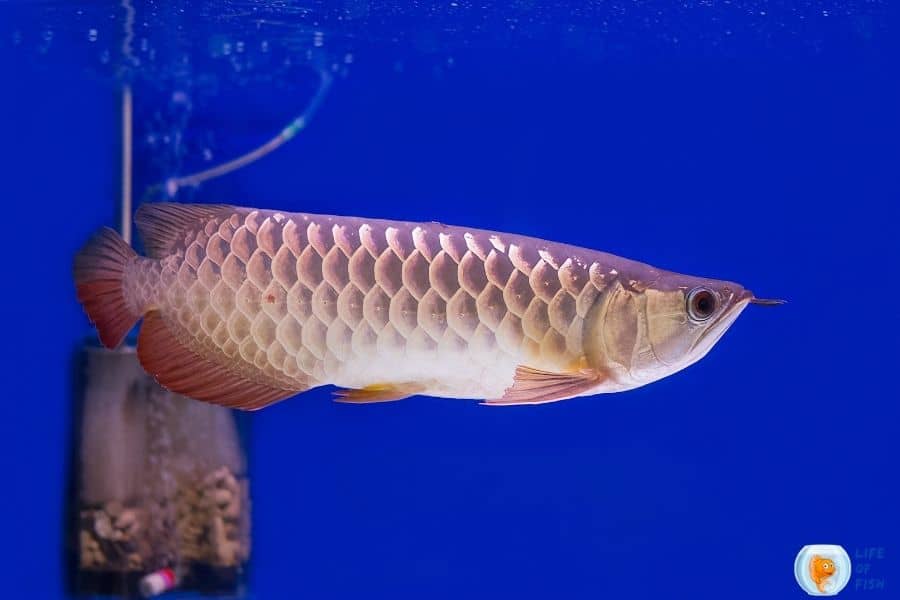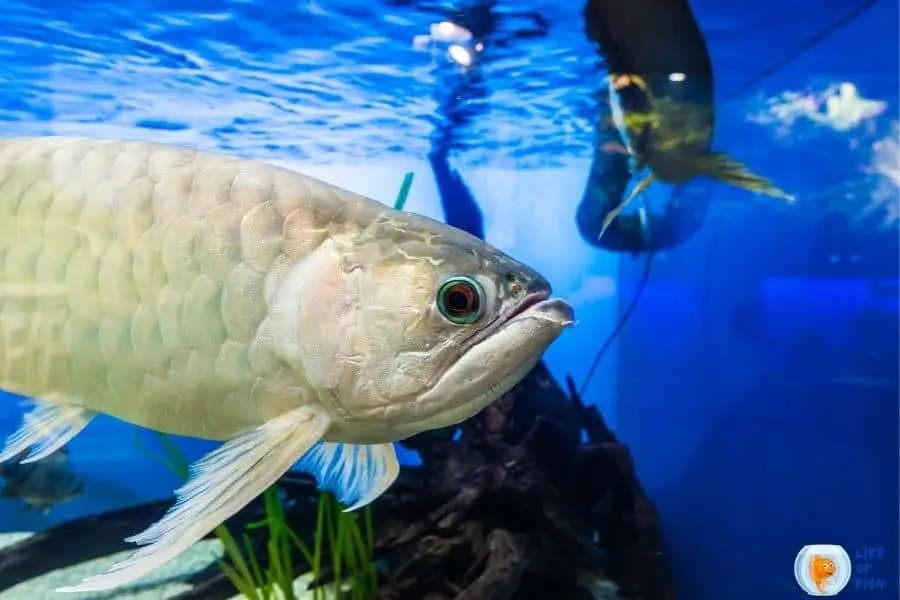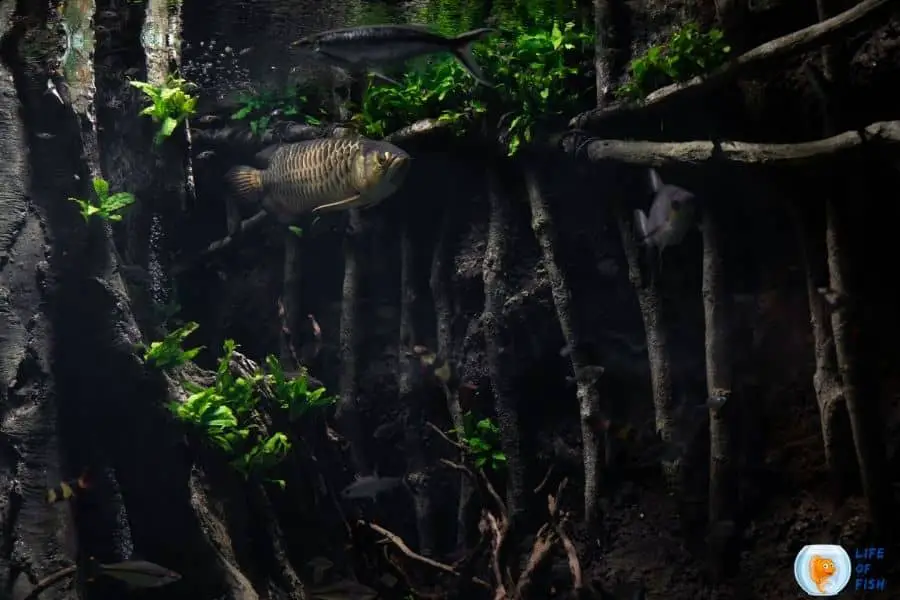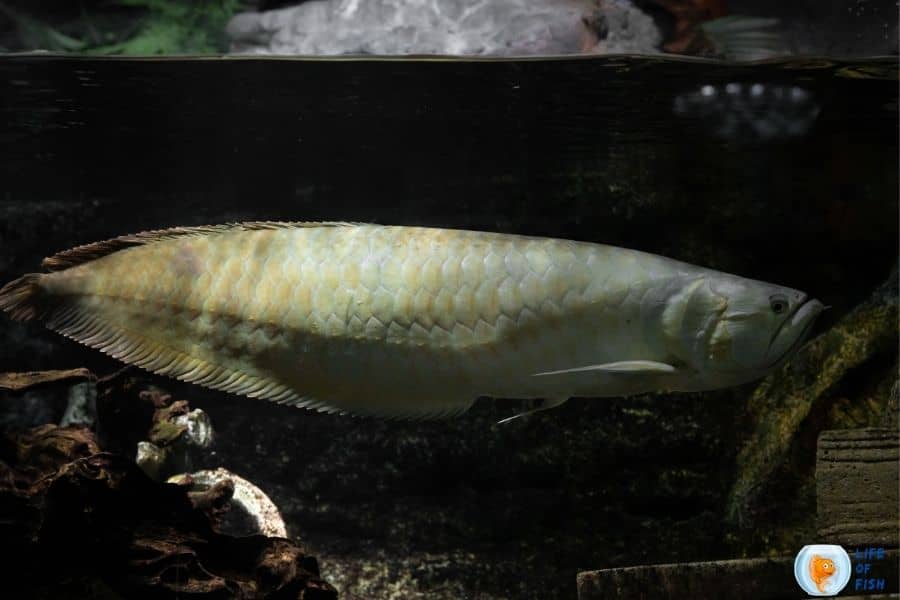Arowana is freshwater fish that come in many different shapes, sizes, and colors. Therefore you need to pay attention to Arowana tank size before purchasing them.
Arowana is popular among aquarists because of its beauty and intelligence. The Arowana is also known as the monkey fish, dragonfish, or lucky fish.
If you want to set up an Arowana tank for your home, there are a few things to consider before doing so.
Here’s what you need to know about how much space your new pet needs, what type of setup will work best for them, and more!

Arowana minimum tank size
Jump To
Arowanas are large fish species that grow about 2 feet or more. Therefore, they need a large aquarium or a pond to live in.
The size of an aquarium or pond required to house a single Arowana depends on the type of species you are choosing.
However, regardless of which one you choose, you must be aware that Arowanas need at least 15 gallons of water per inch in length.
For example, a silver Arowana, which grows up to 60 cm or more needs an aquarium with a minimum of 450 gallons (1800 L) water capacity.
If the tank size required for one fish is too large for you, don’t worry. Arowanas are known to do well in groups as long as they have enough space.
However, the minimum Arowana tank size should be at least 200 gallons of water, but ideally, more than 300 gallon-sized tanks would work well as they get enough space to swim and thrive.
Arowana community tank size
You can house some Arowana species like Silver and Black Arowana with several different tank mates.
However, these fish require large enough space to grow and adapt to their surroundings. Therefore, the Arowana community tank should be much larger than a single species tank.
For a community tank with about 3 Arowanas, you will have to provide at least 700 to 1000 gallon tank.
If you build a pond, we recommend a minimum of 10′ X 4′ X about 18 inches deep to accommodate all the Arowanas.
Arowana breeding tank size
If you plan on breeding Arowanas, then you need a breeding tank for this.
Breeding tanks are at least 600-gallon tanks that provide suitable conditions for spawning and rearing baby fishes until they reach adulthood. They also need their own ponds or large aquariums to live in.

Arowana Minimum Tank Size by Breed
| Type | Tank size |
| Silver Arowana (Osteoglossum bicirrhosum) | 250 gallons |
| Black Arowana (Osteoglossum ferreirai) | 240 gallons |
| Australian Arowana (Scleropages jardinii) | 200 gallons |
| Saratoga (Scleropages leichardti) | 200 gallons |
| Green Arowana (Scleropages formosus) | 250 gallons |
| Banjar / Yellow Tail Arowana (Scleropages formosus) | 250 gallons |
| Golden Arowana (Scleropages formosus) | 200 gallons |
| Red Tail Golden Arowana (Scleropages formosus) | 250 gallons |
| Red Arowana (Scleropages formosus) | 250 gallons |
| Batik Arowana (Scleropages inscriptus) | 300 gallons |
| African Arowana (Heterotis niloticus) | 250 gallons |
| Albino Arowana | 200 gallons |
| Platinum Arowana | 300 gallons |
| Jardini Arowana | 200 gallons |
| African Arowana | 250 gallons |
| Asian Arowana | 300 gallons |
| Super Red Arowana | 250 gallons |
How to setup Arowana tank
Setting up an Arowana tank is not difficult, but it can be expensive depending on the type of fish you want.
If you choose to house only one single species, then a standard freshwater fish setup will work well for your new pet.
However, if you plan to have a community tank with several species, you will need to build large Arowana tanks or ponds.
Arowana habitat requirements
Silver and Black Arowanas can do well in both freshwater and brackish water habitats.
However, these fish require very large space for their long bodies to swim freely without any hassles. They can also adapt to a wide range of water conditions and temperatures.
Arowanas are very intelligent fish that require sufficient space for their enormous bodies so they can move around freely without any restrictions.
If you have the money, time, and effort needed to build an aquarium or pond, then go ahead with your plans!
Otherwise, it might be best to stick with other fish species that will not require much space.
Ideal water parameter for Arowana
Since these are tropical freshwater fish species, the average water temperature should be around 72-82°F.
They prefer alkaline water of pH around 6.5 to 7.5 levels. The water hardness should be about 16DH, and Ammonia, Nitrite levels should be 0ppm.
However, these fish can tolerate a small amount of Nitrate below 30ppm levels.
Substrate for Arowana?
Arowanas are surface-dwelling fish that hardly explore the bottom of the tank. So, adding a substrate is not necessary.
However, you can use an open gravel substrate to make it look like a natural habitat.
If you choose not to add any substrate, you will have to frequently clean your tank with a vacuum cleaner. But, it will be easier than having a substrate in your Arowana tank.
Do Arowanas need plants?
Arowanas do not require plants but having some of them helps these fish to hide when they feel stressed or threatened.
You can add some aquarium plants to make your fish feel secure and comfortable in their new home.
What Lighting Does Arowana Need?
Arowanas do not require lighting to thrive in their home, but lighting up your tank will highlight your expensive fish beautifully.
Each Arowana species need different colored lights to show their unique and colorful patterns.
For example, red Arowanas highlighted best with black background colors, while gold Arowanas do best with lighter white colors.
So, you should research the best lighting for your Arowana species before buying them.
Do Arowanas need a filter system?
Absolutely. Arowana fish are enormous fish that produce a huge amount of waste in their water.
Therefore, you will need to install the best filter system to handle your Arowanas tank load without any problems.
In our experience, canister filters or SUMP systems are the best ones to use in the Arowana tank.
However, you will have to research various filters available on the market before making your final choice for this critical part of your aquarium equipment.
Additionally, you can supplement your tank with biological filtration by adding some beneficial bacteria to your tank.
The beneficial bacteria will help to break down the chemicals in your fish water, making it cleaner for your Arowanas.

Arawana tank mates
As large predatory fish, Arowanas tend to eat smaller species, so it’s best not to keep them with any smaller and same-sized fishes as Arowanas will almost certainly attack and kill any other small species.
Also, their aggressive nature and large size make them strict territorial fish. So it is best to keep them alone.
You will have to keep Arowanas in separate tanks or ponds if you have more than one of the same species.
However, some species like Silver Arowana, Black Arowana, and Red Arowana get used to staying together if they are introduced at a juvenile age, and when you provide large enough space for them to swim around when they grow up.
They also tend to get along with larger species of fish only when introduced at a juvenile age so that you may keep them in community tanks.
On the other hand, Jardini Arowanas are more aggressive than other Arowana species, so it’s best to keep them alone.
You will not be able to house Jardini Arowana with any other fish (even other Jardinis) because these fish tend to attack any fish that comes near their territory. And, they are terrible attackers.
For Arowanas that can live on community tanks, some suitable tank mates are relatively large species that can defend themselves if an attack occurs.
So, these tank mates should also be fairly aggressive. The larger size will make these fish too big for being the prey of Arowanas. Therefore, they will be fine living with Arowanas.
Some suitable Arowana/ Silver Arowana tank mates are,
- Large catfish
- Silver Dollar Fish
- Large Plecos
- Bichir
- Parrotfish
- Jaguar Cichlid
- Pacu
- Green Terror Cichlid
- Black Ghost Knife Fish
Arowanas are enormous fish that require large tanks with ample amount of space for swimming and surface diving, Not to mention the strong filter system you will need just as much.
So, if your tank is small or has only one filtration system, you may not be able to house more than one Arowana in your tank.
Additionally, you should also remember that Arowanas are highly aggressive fish, so be sure to research their specific needs before purchasing one.
Arowana feeding
As it is predator fish they prefer to have live food. But in the aquariums, they also survive with frozen foods.
As for me, I prefer frozen foods because they are cheaper than live food.
Setting up your Dragon’s Den (Arowana Tank)
Many people call the Arowana tank “Dragon Dens” because this fish’s alias name is “Dragon Fish.” They are also aggressive like so-called Dragons and have a magnificent look like the mythical Dragon.
When you set up your Dragon den, there are several essential things to keep in your mind.
Monster fish needs larger tanks
Arowanas are monster fish that grows about 2 feet or more, even in captivity. So, they need an ample amount of space to swim, dive, and move around.
That’s why; you will need a large tank for your Arowanas that can provide them an ideal environment they like.
The minimum size of the tank should be at least 100 gallons (for juveniles) or 200 gallons (for adults). And this is just a bare requirement for the smallest Arowana species, which is Jardini Arowana.
However, for other Arowana species like Silver and Green Arowanas, you will need much larger tanks.
When setting up your tank, you should also take notes about the width of the tank.
For example, if you set up a tank with a length of 36 inches and a width of 18 inches, then this is not good for your Arowana because the minimum required size should be at least 48 x 24 inches.
This is because when they get bigger in terms of age, their body will stretch longer than before.
Thicker tank glass provides more protection
Arowanas are powerful enough to break the tank’s glass if it is less than half an inch thick, so you should provide a thicker and stronger one.
So are Strong hoods
Also, ensure that your aquarium has a strong enough hood with locks because they are strong enough to pull off lighter hoods when they jump.

Arowanas are “Fish that needs strong filtration.”
Another thing you should consider is the power of your filter system.
A standard aquarium filter may not be enough for large fish like Arowana, so choose stronger filters with higher capacity to provide a better environment and keep their tanks clean.
You can also use more than one filter to provide better filtration for your Dragon’s den.
One more thing. Arowana can be sensitive fish, so purchase a good quality filter because some cheap products may cause problems like ich, fungus infection, or lead them to illnesses in general which is not good for your Arowanas.
If you choose a strong filter system, there is no need to add any extra equipment or devices in the tank like air pumps or oxygenators because their filters will do all of it.
The stand should also be strong and sturdy.
You must construct your tank with an aquarium stand before installing the fish tank in it.
If you are using large water basins (like Rubbermaid) as your fish tank, you can just place them on the floor.
However, if it is a glass aquarium tank ideal for Arowanas, you will need to purchase an extra tall and strong cabinet or stand because they weigh about 1700 pounds at least.
So you will have to use an extra-strong stand for your Arowana tank.
Also, remember to use a wide stand more than 25 inches instead of narrow stands. This is because if you choose narrower stands, your tank may become unstable when large Arowanas jump, which can cause great problems for both the fish and you!
Conclusion
Arowana tank size, setup, and requirements are all discussed in this article.
If you plan to keep Arowanas for home or business purposes, it’s important to have the proper knowledge about what they need.
By reading this article, we believe that you have learned all the basic details on Arowanas and their needs.
Read More: African Arowana | 16 Facts That Nobody Told You About |
